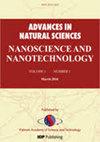Chitosan derived N-doped carbon aerogel nanostructures for high-performance supercapacitors
IF 2.1
Q3 MATERIALS SCIENCE, MULTIDISCIPLINARY
Advances in Natural Sciences: Nanoscience and Nanotechnology
Pub Date : 2024-09-02
DOI:10.1088/2043-6262/ad71a4
引用次数: 0
Abstract
This study presented a chitosan-derived activated carbon aerogel material (ACAM), which was prepared via a sol–gel method, freeze-drying, and carbonization. The prepared nitrogen-doped carbon materials had nanopore structures with a highly specific surface area of 2341 m2 g−1 that was expected to be suitable as active electrode materials for supercapacitors). The prepared electrode exhibited a high capacitance of 215 F g−1 at 1.0 A g−1. Moreover, the electrode could retain almost 93% of the original capacitance, and the Coulombic efficiency remains over 97% after 5,000 cycles. The findings suggest a low-price and high-performance material for supercapacitors.用于高性能超级电容器的壳聚糖衍生 N 掺杂碳气凝胶纳米结构
本研究介绍了一种壳聚糖衍生的活性炭气凝胶材料(ACAM),该材料通过溶胶-凝胶法、冷冻干燥和碳化制备而成。制备的掺氮碳材料具有纳米孔结构,比表面积高达 2341 m2 g-1,有望成为超级电容器的活性电极材料。)制备的电极在 1.0 A g-1 的条件下具有 215 F g-1 的高电容。此外,该电极可保持近 93% 的原始电容,库仑效率在 5,000 次循环后仍保持在 97% 以上。这些发现为超级电容器提供了一种低成本、高性能的材料。
本文章由计算机程序翻译,如有差异,请以英文原文为准。
求助全文
约1分钟内获得全文
求助全文
来源期刊

Advances in Natural Sciences: Nanoscience and Nanotechnology
NANOSCIENCE & NANOTECHNOLOGYMATERIALS SCIE-MATERIALS SCIENCE, MULTIDISCIPLINARY
自引率
4.80%
发文量
0
 求助内容:
求助内容: 应助结果提醒方式:
应助结果提醒方式:


